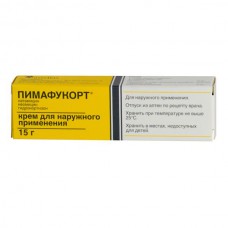Expiration date: 02/2025
The composition and form of issue:
Cream. 1 g contains:
natamycin 10 mg
neomycin (as neomycin sulfate) 3500 IU
hydrocortisone micronized 10 mg
auxiliary substances: sodium citrate 14 mg emulsifier F — 115 mg sorbitan stearate 30 mg wax tetravinyl 60 mg cetiol V 150 macrogol stearate 100 — 20 mg methyl parahydroxybenzoate 2 mg parahydroxybenzoate — 0.5 mg purified water up to 1000 mg
in aluminum or plastic tubes to 15 grams in a box 1 tuba.
Ointment. 1 g contains:
natamycin 10 mg
neomycin (as neomycin sulfate) 3500 IU
hydrocortisone micronized 10 mg
excipients: PE ointment base (95% of liquid paraffin, 5% PE) to 976, 5 mg
in aluminum or plastic tubes to 15 grams in a box 1 tuba.
Description pharmaceutical form:
Cream: white to white with a yellowish sheen color.
Ointment from white to yellow.
Pharmacokinetics:
Natamycin and neomycin is practically not absorbed through the intact skin and mucous membranes. Possible absorption of neomycin through the damaged skin in contact with the drug for wounds, ulcers. Through the intact skin is absorbed 1 to 3% hydrocortisone for dermatitis the amount of hydrocortisone absorbed is increased by 2 times, when infectious skin lesions can increase by up to 5 times. In children the absorption of hydrocortisone through intact skin is higher than in adults, the degree of absorption of the drug into the systemic circulation decreases with age.
Description pharmacological action:
Neomycin is a broad-spectrum antibiotic of the aminoglycoside, active against number of gram-positive (Staphylococcus spp., Enterococcus spp.) and gram-negative (Klebsiella spp., Proteus spp. Escherichia coli, etc) bacteria.
Natamycin belongs to antifungal drugs of polyene series, has a fungicidal activity against yeasts and yeast-like fungi, particularly Candida spp. Dermatomitsety less sensitive to natamycin.
Hydrocortisone has anti-inflammatory and vasoconstrictor effect.
Eliminates inflammation and itching that accompany various types of dermatoses.
Indications:
Dermatoses amenable corticosteroids therapy complicated by secondary bacterial and/or fungal infection (especially caused by fungi of the genus Candida).
Contraindications:
- hypersensitivity to the drug
- tuberculosis skin, skin manifestations of syphilis, viral skin infection, post-vaccination skin reactions, open wounds, ulcers
- acne, rosacea, ichthyosis
- anogenital pruritus, skin tumors.
With caution:
tuberculosis (systemic failure)
children up to age 1 year
in patients with a history of indications of the defeat of the IX pair of cranial nerves against the background of the use of aminoglycosides
the presence of perforation of the tympanic membrane and the direct impact of neomycin in the middle ear (there is a risk of ototoxic action).
Application of pregnancy and breast-feeding:
In appointing the drug during pregnancy it is necessary to consider the theoretical risk of ototoxic action of neomycin, thus it is not possible to use the drug for a long time and put it under an occlusive bandage.
Side effects:
Side effects for external use Pimafucort as the use of other GCS, are rare, and are reversible.
Rarely may develop a hypersensitivity reaction (itching, burning, redness or dryness of the skin).
Very rarely atrophy and thinning of the skin, telangiectasia, striae, purpura, rosariopatsy and perioral dermatitis, slow wound healing, depigmentation, hypertrichosis, syndrome after cessation of treatment.
When using external GKS for a long time on large areas of skin or when using occlusive dressings, especially in children may develop side effects typical of corticosteroids systemic effects such as suppression of adrenocortical function.
Contact dermatitis in the application of neomycin.
Drug interactions:
May be cross-hypersensitivity between neomycin, kanamycin, paromomycin, gentamicin cross-resistance between neomycin and other aminoglycoside antibiotics group.
Method of application and dose:
Externally. Adults and children the drug is applied to the affected areas of skin 2-4 times a day. The duration of treatment is determined individually, taking into account the nature of the disease, the treatment usually does not exceed 14 days.
The children used under medical supervision, the drug should be applied on limited areas of the skin not to apply occlusive dressings.
In the form of a cream is a drug recommended for the treatment of acute and subacute dermatoses, including accompanied by weeping. The ointment is intended for treatment of subacute and chronic dermatoses, especially in the presence of severe dry skin, lichenification, seborrhea or in cases when the desired occlusive properties of the ointment.
Overdose:
Information about drug overdose is not. It is theoretically possible ototoxic action of neomycin in the case of application of the drug to the area of the external auditory canal when the presence of perforation of the tympanic membrane and the direct impact of neomycin into the middle ear.
Special instructions:
When applying Pimafucort on the eyelids and periorbital region exists the risk of increased intraocular pressure, cataract development.
In applying the drug in children, on large surfaces or under the bandages you need to keep in mind the possibility of the suppression function of the hypothalamic-pituitary-adrenal axis.
In the case of prolonged treatment, the presence of wounds and ulcers there is a theoretical risk of ototoxic and nephrotoxic action of neomycin.
The appearance of superinfection or excessive growth of fungi, discontinue use of the drug and to take appropriate action.



